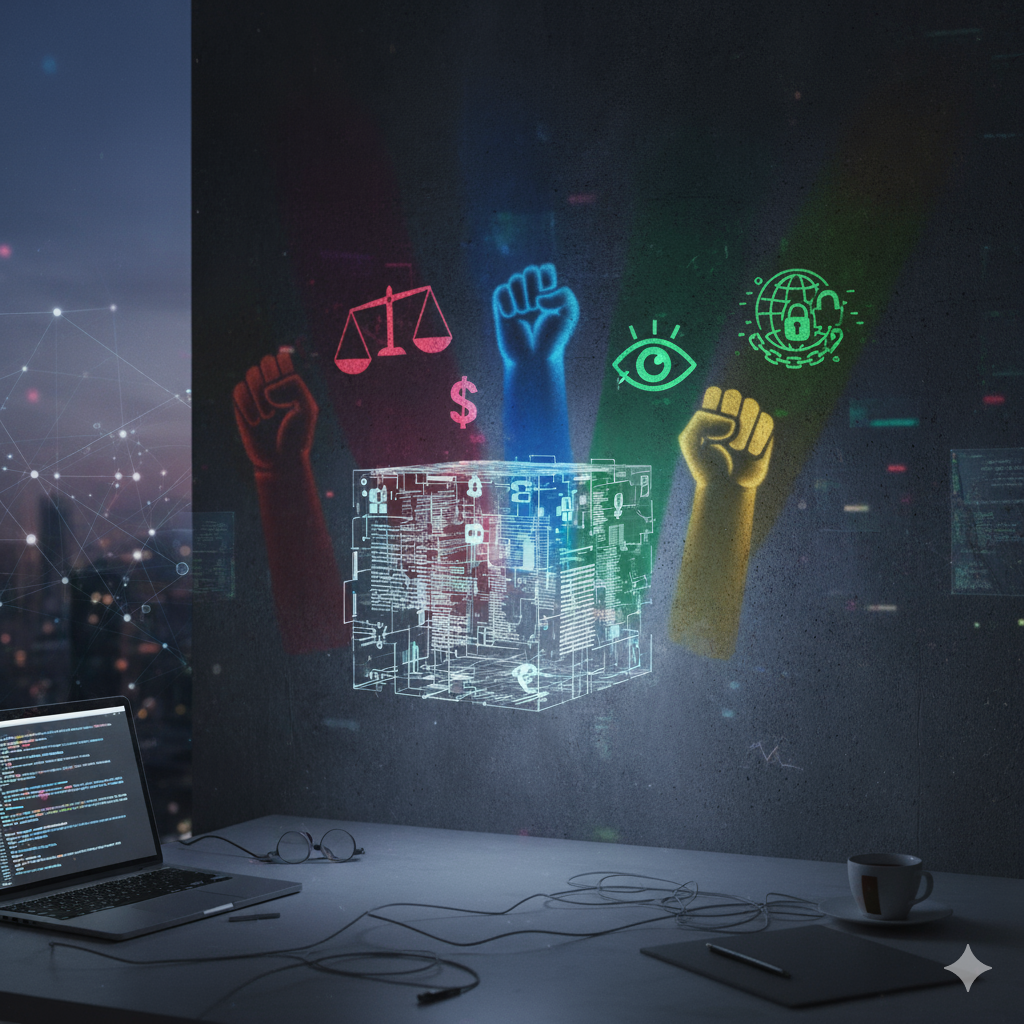“Every line of code is a vote for a certain kind of future.”
Let’s start with a hard truth: code isn’t just about logic, loops, and semicolons — it’s about power.
Every algorithm, every interface, every “Accept All Cookies” button is quietly shaping the world you live in.
So when someone says, “Relax, it’s just software,” you can smile politely — because you know better.
Software is politics in binary. It’s democracy written in JavaScript. It’s ideology compiled and deployed to production.
🧠 1. Embedded Values and Biases in Design
Imagine your codebase as a mirror — it reflects not just syntax but the soul of its creators.
Every if statement carries an “if” about who is considered, and who is left out.
- Human Decisions: Code doesn’t spring from the ether; it’s written by humans with worldviews, caffeine dependencies, and subconscious biases. As media theorist Wendy Chun reminds us, “There’s never a purely technological solution to a political problem.” Translation? You can’t debug inequality with a
forloop. - Algorithmic Bias: Feed an algorithm biased data, and it’ll spit out injustice faster than ChatGPT can say “fairness.” When predictive policing tools over-target certain communities or job-screening AIs favour male candidates — that’s not just math; that’s math with an agenda.
- Control and Power: Programming languages themselves mimic hierarchy. The programmer issues commands; the machine obeys. It’s a microcosm of domination. Some radical developers even toyed with creating feminist programming languages to challenge this dynamic — imagine a syntax where collaboration replaces command.
Think of it this way: if programming were a religion, the compiler is the high priest, deciding what is valid and what gets excommunicated with a red error message.
💰 2. Structural and Economic Power
Software doesn’t just exist in the world — it reshapes it.
- Proprietary vs. Free Software: This isn’t just a licensing issue; it’s a modern-day ideological war. The Free Software movement shouts “freedom!” while proprietary software quietly whispers, “You can use it… but only as long as we say so.” It’s like choosing between renting your home in the digital kingdom or owning your virtual land.
- Market Disruption and Labor: When Uber, Airbnb, or Amazon say they’re “democratizing access,” what they often mean is rearranging the power structure — shifting risk to individuals while capturing global profit. For every “innovator,” there’s a taxi driver, hotel owner, or warehouse worker feeling the disruption.
- Corporate and Government Influence: Who funds the code? Who benefits from it? Early computing was bankrolled by governments chasing military advantage. Today, Big Tech bankrolls “innovation” to collect more data. Whether it’s the Pentagon or Palo Alto, the priorities often rhyme: control, efficiency, and surveillance.
In short: every “update” comes with an agenda — sometimes fixing bugs, sometimes fixing democracy (for better or worse).
🌐 3. Societal Consequences and Impact
Software isn’t just shaping your screen time — it’s shaping your social contract.
- Code is Law: As legal scholar Lawrence Lessig wrote, the architecture of cyberspace regulates human behavior as effectively as laws do. If a platform doesn’t let you post something, it’s not censorship by the government — it’s censorship by design. The moderators wear hoodies, not robes.
- Protestware and Activism: Developers are no longer just building tools; some are throwing digital Molotov cocktails. From open-source “protestware” injecting political messages, to social media platforms fueling revolutions — software has become the new picket line.
- Security and Privacy: Every toggle, checkbox, and privacy policy is a political choice. Who can see your data? Who profits from it? Who protects it? Surveillance capitalism thrives on our consent — or more accurately, our scroll-through-and-click-“I Agree” apathy.
Your phone isn’t just a device; it’s a citizenship card for a digital nation whose constitution is written in code.
🧩 The Illusion of Neutrality
To claim that “code is neutral” is like saying a referee can’t influence a game because they don’t play. Of course they do — every whistle, every blind spot, every call (or lack of one) changes the outcome.
Likewise, code defines who gets to play, who gets penalized, and who gets left out of the match entirely.
Neutrality, in this context, isn’t peace — it’s denial. It’s pretending that power doesn’t exist simply because you wrapped it in an API.
💡 Final Thought
The next time someone commits code and says, “It’s just a feature,” remember:
That feature might amplify voices or silence them.
It might open access or lock the gate.
It might protect privacy or auction it off to the highest bidder.
Code isn’t just running on servers — it’s running society.
And like all power, it demands responsibility.
So, commit wisely.
“The only truly neutral code is the one that never runs — and even that’s a political choice.”

Leave a Reply